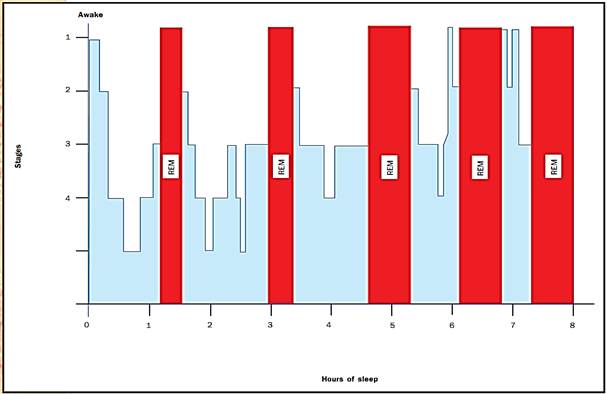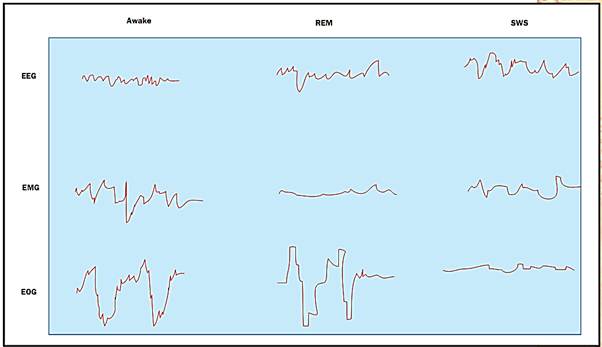


 النبات
النبات
 الحيوان
الحيوان
 الأحياء المجهرية
الأحياء المجهرية
 علم الأمراض
علم الأمراض
 التقانة الإحيائية
التقانة الإحيائية
 التقنية الحيوية المكروبية
التقنية الحيوية المكروبية
 التقنية الحياتية النانوية
التقنية الحياتية النانوية
 علم الأجنة
علم الأجنة
 الأحياء الجزيئي
الأحياء الجزيئي
 علم وظائف الأعضاء
علم وظائف الأعضاء
 الغدد
الغدد
 المضادات الحيوية
المضادات الحيوية|
Read More
Date: 14-10-2015
Date: 19-10-2015
Date: 14-10-2015
|
Sleep
Sleep is a very important process and is characterized by a stereotypical posture, little movement, and a decrease in response to stimuli. These characteristics might also describe coma, but in sleep, unlike in coma, the characteristics are reversed each morning. Because creatures are not eating or mating and are also very vulnerable to attack by predators during sleep, sleep must have a very important function to make it worthwhile.
Sleep is also a very insistent drive. Whereas a person can voluntarily stop eating until he or she dies, the human body cannot force itself to stay awake indefinitely. In fact, there are situations when falling asleep might mean death (while driving a car, for example), yet the desire to sleep is so insistent that body will still succumb to it.
Stages of Sleep
Sleep is divided into two main stages: REM sleep (which stands for “rapid eye movement”), and non-REM (NREM) sleep. These stages are characterized by changes measured on instruments such as the electroencephalograph (EEG), which measures changes in electrical signals in the brain; electrooculogram (EOG), which measures eye movements; and the electromyogram (EMG), which measures muscle movements. In humans, REM and NREM sleep alternate in ninety-minute cycles approximately three to six times per night. During the first part of the sleep cycle, REM sleep takes approximately ten minutes of each cycle, but REM sleep periods become longer and closer together as the course of sleep progresses (see figure 1).
Non-REM sleep is divided into four stages. As one progresses from stage one to stage four, sleep gets deeper and EEG waves become taller and slower; stages three and four are often grouped together and called slow wave sleep (SWS). During SWS, muscle movements and eye movements are diminished in comparison to wakefulness, and the EEG is more synchronized, indicating that large portions of brain tissue are firing together.

Figure 1. Stages of sleep.
REM sleep is characterized by a desynchronized EEG, a lack of thermoregulation, loss of tone in the skeletal muscle, erections of the penis or clitoris, rapid eye movements, and dreams. As seen by the desynchronized EEG, which is similar to the brain patterns seen during wakefulness, the brain is very active during REM sleep. However, one part of the brain that does shut off during REM sleep is the part of the hypothalamus that is responsible for temperature regulation. During REM sleep, the body does not thermoregulate and therefore does not shiver or sweat.
Skeletal muscles are also less active during REM sleep and thus lose muscle tone. This loss enables the muscles to relax during REM sleep. It also prevents people from acting out their dreams (sleep walking occurs during NREM sleep, when muscle tone is maintained but diminished). Not all muscles lose their tone during REM sleep. The diaphragm, necessary for breathing, continues to contract. Muscles are also active in the eyes: although the lids are closed, the eyes dart back and forth during REM sleep, which gives REM its name.
During REM sleep the penis and clitoris often become erect, but this is not necessarily related to dream content. Although REM sleep is associated with dreams, dreams actually occur during all stages of sleep. The dreams that occur during REM sleep have characteristics different from those dreams in NREM sleep. REM dreams are longer, more emotional, and more visual than NREM dreams, and they usually do not follow the events of the day as closely as NREM dreams.
Neurological Control
A common misconception is that the brain shuts down during sleep. In truth, parts of the brain may be even more active during NREM or REM sleep than during wakefulness. The level of consciousness depends upon the activity of the reticular activating system, a network of neurons in the brainstem that send projections throughout the thalamus, hypothalamus, and cerebral cortex. Certain areas of the brain have been found to be responsible for causing different sleep stages. Whereas NREM sleep is controlled by the basal forebrain (the anterior hypothalamus and adjacent forebrain areas), REM sleep is mostly controlled by an area in the brainstem called the pons.
Functions of Sleep
Although humans spend approximately one-third of their lives asleep, no one knows for sure what the function of sleep is. It is known that sleep is necessary for life. Constant sleep deprivation in rats leads to death. Studies suggest that constant deprivation of REM sleep alone causes metabolic changes in rats that can also lead to death.
There are a number of theories on the function of sleep. Sleep may help the body recover from an active day and give it the chance to restore substances that are lost during the day. However, since simply resting the body without sleep does not fulfill the same function as sleep, it is thought that there is more to sleep than resting.

Figure 2 :Electroencephalogram (EEG), electromyogram (EMG), and electrooculogram (EOG) show activity of the brain, muscles, and eyes during three different states: wakefulness, REM sleep, and slow-wave sleep(SWS).
Sleep may have developed evolutionarily as an adaptive mechanism to keep animals out of harm’s way, preventing them from wandering around in the dark, vulnerable to accidents and attack by predators, during a time when food foraging may be less efficient. It is interesting to note that small animals with safe hiding places and large predators sleep a lot, whereas large prey sleep less often, suggesting sleep may be related to an animal’s relative safety, although the evidence for this is far from clear. The question remains, however, why the complex process of sleep would have evolved to merely keep animals out of danger.
It is known that REM sleep is a necessary stage of sleep; however, the function of REM sleep is also unclear. Temporary REM sleep deprivation can lead people to become bad-tempered and uneasy. If REM deprivation continues, and the subject is then allowed to sleep undisturbed, he or she experiences “REM rebound,” which means that REM sleep occurs more frequently and lasts longer than normal. There is evidence that REM sleep is necessary for learning and memory. Furthermore, theorists are proposing that REM sleep may be important in the development of the brain.
References
Carlson, Neil R. “Sleep and Biological Rhythms.” In Physiology of Behavior, 7th ed. Boston: Allyn & Bacon Publishers, 2001.
Myers, David G. “States of Consciousness.” In Exploring Psychology, 4th ed. New York: Worth Publishers, 1999.
Rechtschaffen, A., et al. “Sleep Deprivation in the Rat. X: Integration and Discussion of the Findings.” Sleep 12 (1989): 68-87.
Sleep Research Society. “Basics of Sleep Behavior Syllabus.” WebSciences International and Sleep Research Society, 1997. http://www.sleephomepages.org/ sleepsyllabus/.



|
|
|
|
لشعر لامع وكثيف وصحي.. وصفة تكشف "سرا آسيويا" قديما
|
|
|
|
|
|
|
كيفية الحفاظ على فرامل السيارة لضمان الأمان المثالي
|
|
|
|
|
|
|
العتبة العباسية المقدسة تجري القرعة الخاصة بأداء مناسك الحج لمنتسبيها
|
|
|